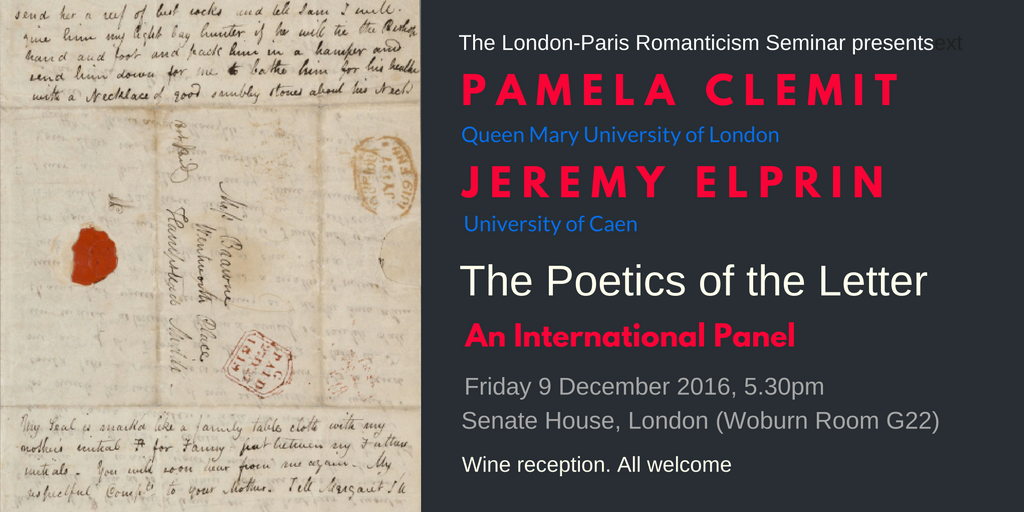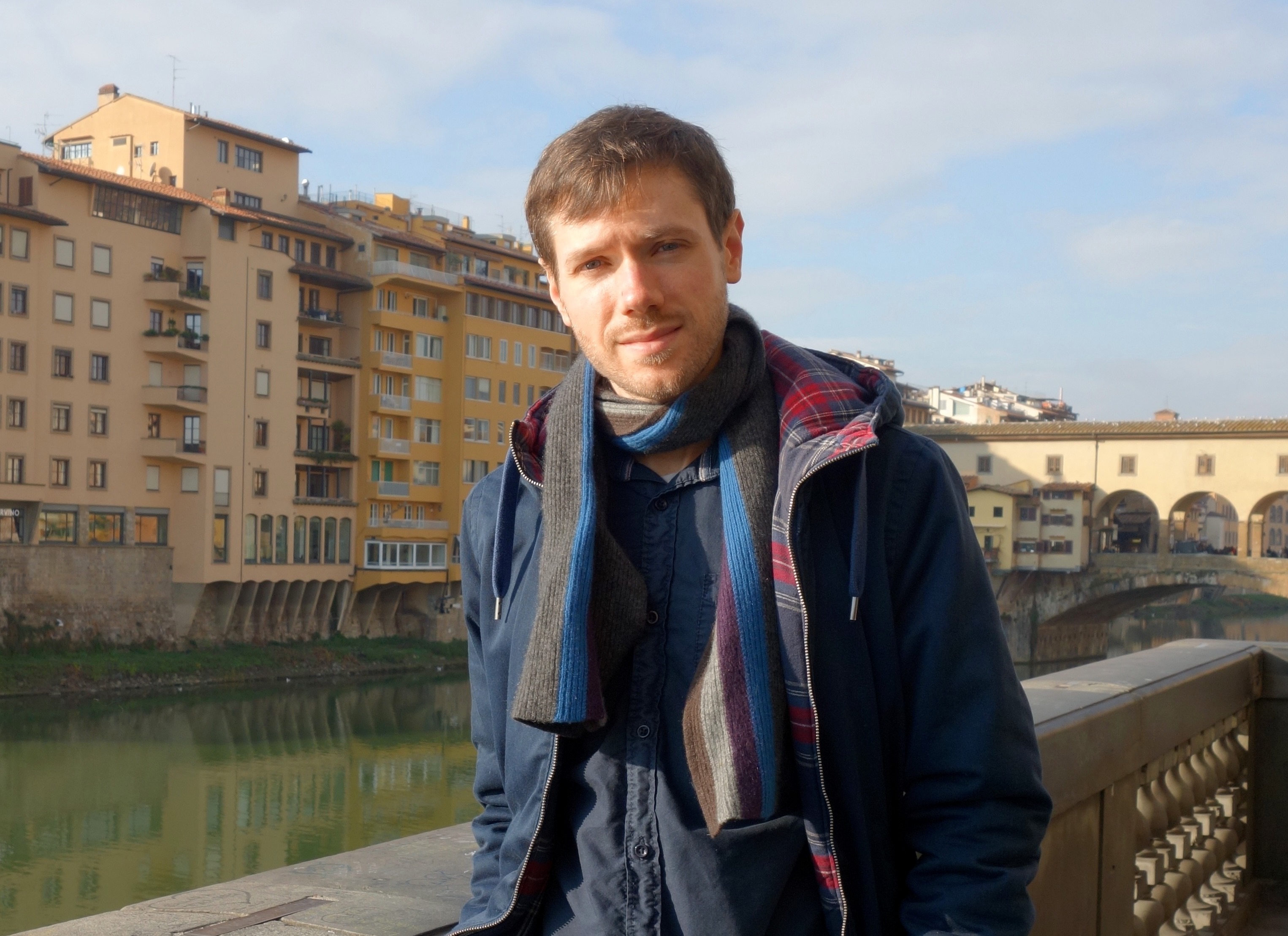
The next meeting of the London-Paris Romanticism Seminar will take place on Friday 9 December and feature an international panel on The Poetics of the Letter. This is the first of our seminars with paired speakers from the UK and France, and we are delighted to welcome two outstanding scholars: Pamela Clemit of Queen Mary University of London, whose talk is entitled Difficult to Make and Difficult to Fake: Signalling in Romantic-Period Letters, and Jeremy Elprin of the University of Caen, the title of whose paper is ‘Qui me néglige me désole’: The Neglected Countenance of Keats’s Letters. The abstracts appear below.
The seminar will be held in the Woburn Room at Senate House (ground floor, G22), starting at 5.30 (please note this is a change from the previously advertised room). The papers will be followed by a discussion and an extended wine reception (till 8.30), to which everyone is invited. Admission is free.
 Pamela Clemit is Professor of English at Queen Mary University of London and a Supernumerary Fellow at Wolfson College, University of Oxford. She is the author of The Godwinian Novel (OUP, 1993, 2001), a standard work in the field, and has published more than a dozen critical and scholarly editions of the writings of William Godwin and of his daughter Mary Shelley. She is the General Editor and principal Volume Editor of The Letters of William Godwin, which is being published by Oxford University Press in six volumes. The volumes published so far (Volume I in 2011, and Volume II in 2014), both edited by her, have been acclaimed by reviewers. She is currently editing Volume IV (1816-1828), which will contain around 350 letters, most of which have not been published before. She has published many journal articles and book chapters on Godwin and his literary associates. She is the recipient of a Keats-Shelley Association of America Distinguished Scholar Award for 2017.
Pamela Clemit is Professor of English at Queen Mary University of London and a Supernumerary Fellow at Wolfson College, University of Oxford. She is the author of The Godwinian Novel (OUP, 1993, 2001), a standard work in the field, and has published more than a dozen critical and scholarly editions of the writings of William Godwin and of his daughter Mary Shelley. She is the General Editor and principal Volume Editor of The Letters of William Godwin, which is being published by Oxford University Press in six volumes. The volumes published so far (Volume I in 2011, and Volume II in 2014), both edited by her, have been acclaimed by reviewers. She is currently editing Volume IV (1816-1828), which will contain around 350 letters, most of which have not been published before. She has published many journal articles and book chapters on Godwin and his literary associates. She is the recipient of a Keats-Shelley Association of America Distinguished Scholar Award for 2017.
 Jeremy Elprin is an early career scholar at the University of Caen, where he teaches English literature and translation. He completed his PhD at the University of Paris Diderot in 2015. Prior to moving to France, he received a BA from Tufts University and an MSt from the University of Oxford. His doctoral thesis probed the textual and theoretical challenges to reading the correspondence of John Keats as an autonomous “literary” corpus (that is, one which is not only secondary or supplementary to the poetic oeuvre). His recent publications include an article in Etudes Anglaises on the ties between Keats’s letters and the posthumous writing of his life, and a chapter on Wordsworth’s poetics of ambivalence in Romanticism and the Philosophical Tradition, ed. Constantinesco and Laniel-Musitelli (Presses Universitaires de Nancy, 2015). He co-founded the postgraduate seminar “Romantic Commons” at the University of Paris Diderot in 2014.
Jeremy Elprin is an early career scholar at the University of Caen, where he teaches English literature and translation. He completed his PhD at the University of Paris Diderot in 2015. Prior to moving to France, he received a BA from Tufts University and an MSt from the University of Oxford. His doctoral thesis probed the textual and theoretical challenges to reading the correspondence of John Keats as an autonomous “literary” corpus (that is, one which is not only secondary or supplementary to the poetic oeuvre). His recent publications include an article in Etudes Anglaises on the ties between Keats’s letters and the posthumous writing of his life, and a chapter on Wordsworth’s poetics of ambivalence in Romanticism and the Philosophical Tradition, ed. Constantinesco and Laniel-Musitelli (Presses Universitaires de Nancy, 2015). He co-founded the postgraduate seminar “Romantic Commons” at the University of Paris Diderot in 2014.
Abstracts: The Poetics of the Letter: An International Panel
Difficult to Make and Difficult to Fake: Signalling in Romantic-Period Letters
Romanticism was not just about the high points of insight and emotion: people lived ordinary lives, nourished by bonds of reciprocity. If people were separated by distance, reciprocity was sustained by letters. Letters are a gift of attention. They convey regard or approbation by means of a signal crafted uniquely for the recipient. The personalisation of the gift signal creates an obligation to reciprocate. Attention to the material culture of letter-writing shows that Romantic writers were self-conscious about this obligation and worked hard to fulfil it — with varying degrees of success. The signals they once created for each other may now be received by us.
Pamela Clemit
‘Qui me néglige me désole’: The Neglected Countenance of Keats’s Letters
Throughout his correspondence, John Keats displays an acute sensitivity to the visual identity of his letters, as well as those of his correspondents. He calls attention to the diverse instruments involved in the composition of a letter, from ink and quill to sealing wax and seal-stamp, and on several occasions alludes to the size, shape, weight, and coarseness of his letter paper. Keats’s letters have been extensively studied but an over-reliance on the printed texts rather than the original manuscripts (many of which have now been digitised by the Houghton Library in Harvard) has resulted in a limited, or at times confused, understanding of Keats’s investment in the material page. It is only by returning focus to visual features of the manuscripts that we can gain a fuller picture of his “epistolary poetics”. This paper will explore some of the possibilities for reading the material in and of this canonical body of writing by invoking the textual pleasures of the French theorist Roland Barthes while also enlisting Keats’s own terms for deciphering what he calls (writing to his sister in December 1819) the “Countenance” of a letter.
Jeremy Elprin
We hope you can join us for this unique event.
David Duff (Queen Mary University of London)
London Director, London-Paris Romanticism Seminar